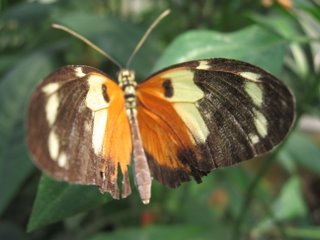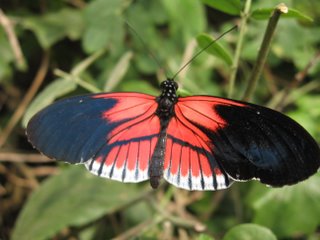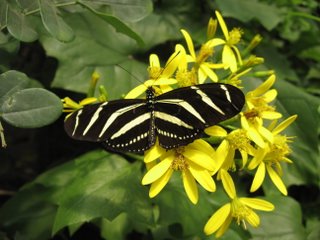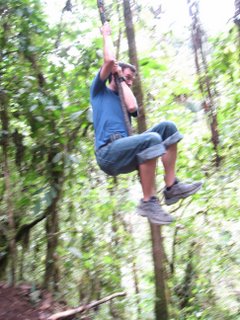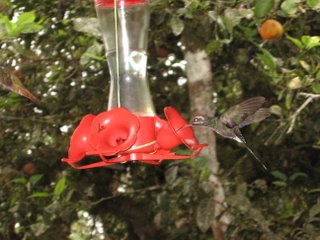Long time, no blog
Sorry I haven´t posted a new entry for quite awhile. It turns out that taking one on one Spanish lessons for 4 hours in the morning and then working in an emergency room for 4 hours in the afternoon can really tire a person out. I´ll try to briefly catch you up on what has happened since the last entry. This will be short, sweet, and without many details for a couple of reasons. 1) I´m now in an internet cafe, as opposed to using the computer in my school, which means that I am paying for this time. Plus, the cafe is busy, uncomfortable, and loud.
2) I´m running seriously low on money, and therefore can´t spend all afternoon on the Internet.
3) I´ve decided that I´m spending way too much time on the Internet blogging, emailing, and trying to shuffle my money and bills around through different bank accounts. It dawned on me that is not a good use of time when in a country like Ecuador. Plus, I´m tired of trying to keep this blog updated.
4) I have better things to do.
World Cup Update: Ecuador ended up losing to Germany 3-0, but it didn´t matter because they had already qualified for the elimination round. They subsequently lost their first game of the elimination round to England 1-0, thanks to a questionable penalty and a free kick by Beckham. In spite of the loss, there was much partying in Ecuador - I think because they considered just qualifying for the elimination round a victory and their showing against England was impressive.
The ER: I worked 3 days a week in an ER at a local hospital. Needless to say, I gained some valuable medical, Spanish, and medical Spanish experience. Also, I saw some really interesting cases and learned a bit about medical care and education in Ecuador. That´s about all that I have to say about that.
Papallacta: Two weekends ago I went to a little town called Papallacta, which is located about 1.5 hrs East of Quito in the mountains, with the same group of summer missionaries from HCJB. There are some amazing natural hot springs there, and the HCJB ministry has a guest house there as well. Basically the weather was pretty bad all weekend. From the moment we arrived until we left the clouds didn´t lift (we were basically in them) and it rained/misted all weekend. But it didn´t matter, we had a comfy fireplace going all the time, plenty of board games, too much good ol´ American food, and of course, the hot springs (which, I might add, are even more enjoyable when the weather is cold and rainy). So all I did was eat, sleep, play games, laugh, sit by the fire, and soak in the hot springs at night - it was great.
Spanish: In spite of my suspicions to the contrary, I am in fact learning quite a bit of Spanish. This was confirmed by the beginning of my formal medical Spanish language program this past week. Although I am still in the beginner´s group, I am near the top of it. Having 30+ other Gringos around me that speak the same level or less of Spanish as me has improved my confidence in what I have been learning. I am now getting around fairly easily on the street and in businesses. In fact yesterday, I was in a bank trying to figure out why my debit card won´t work here (completely in Spanish), and actually was able to resolve the problem - something I was skeptical about being able to do when I walked in.
The Program: There are 36 U.S. first year medical students in my program with me. It hasn´t been quite what I expected so far. We haven´t really had a whole lot of Spanish instruction. Instead, we´ve had to sit and listen to the director (a doctor from Florida) ramble on and on about stuff we already know - like jet lag, oral rehydration solutions, the fact that healthcare is worse in third world countries, etc. To be honest, it has been a bit disappointing. I am glad that I showed up 4 weeks early to take Spanish lessons on my own, otherwise I would be learning nothing. Many students have talked about trying to drop out of the program at this point, or at least ignoring much of the itinerary and trying to learn on their own. I don´t blame them. I´m going to stick with it and try to make the best of it. Things should improve - we leave for a smaller, more rural city called Otavalo tomorrow morning. It is known for its amazing indigenous craft market. We will be spending two weeks around there, observing the clinics there, the native culture, some traditional healers (whose main treatment involves live guinea pigs), and continuing to have limited Spanish lessons. We then travel to the rainforest for a week. If I don´t update this thing over the next few weeks, this is why. One good (and difficult) experience from the program thus far was yesterday. We spent the morning at a mercado where people from around the area are selling all types of foods and goods. We set up a makeshift clinic to see and assess the children whose parents work there everyday. Needless to say, we were swamped - there were more kids than we could have seen in a week. Also, since we are all only first year medical students who only know how to shine lights in peoples´mouths, look in their ears, and pretend like we hear something through our stethoscopes (not to mention the fact that most of us speak marginal beginner´s Spanish at best) not much actual medical care was given. I saw more rotten teeth than I have seen in my life. Every other child either had a GI infection, diarrhea, sore throat, sinusitis, cough, or any combination of these and other common illnesses. But all we could do was pat them on the head, smile, give them a free pencil (which is what they really cared about), and say we were sorry that they couldn´t afford the ibuprofen or pseudephedrine that would make them feel better and that we didn´t have enough to give to them all. It was heartbreaking, frustrating, eye-opening, but in the final analysis, I think better than nothing. They didn´t have to pay for this little clinic, it gave the kids something to do instead of sit in the hot sun and work or beg for money, and most importantly made them feel like someone actually does care about them. We touched them, hugged them, laughed with them, and at least pretended to do something for their health and well-being. We did in fact do some medical good - we distributed free anti-parasite medication to all and had some free medications to give to some of the patients. However, it causes me to return to my original question of what long-term good can we as doctors do for people living in situations like this. I have yet to hear an acceptable answer.
The chocolate donut of death: So on Monday evening during dinner I wasn´t feeling so great. I was a bit nauseous and lacked an appetite (something very rare for me here). Then all of a sudden, in the middle of one of my host dad´s sentences, I had to run from the table to the bathroom and some serious vomiting ensued. I spent the rest of the night tossing and turning on my bed (with an occasional trip to the bathroom) analyzing what I had eaten that day. All I could think of that was out of the ordinary was a chocolate donut that I had purchased at a small shop around noon - due to the fact that we weren´t scheduled to eat lunch in our program until 2:45 pm. It was the only thing different that I had eaten between me and another med student living with my same family. Everyone thinks that I´m crazy and they say that you can´t get that sick from a baked good (especially a donut), but I beg to differ. Who knows what it was, but I´m going to avoid chocolate donuts the rest of my time here just in case. I´m better now.
That´s a brief update on my life to this point. I have a lot more to experience and will be pretty busy from here on out. I´ll try to drop a line here and there, but please don´t expect an update often. I leave Ecuador on August 10. But before then, on the list are: the rainforest, mountain climbing, the beach, the crafts market, indigenous culture, and more. So for now, I´m off...

